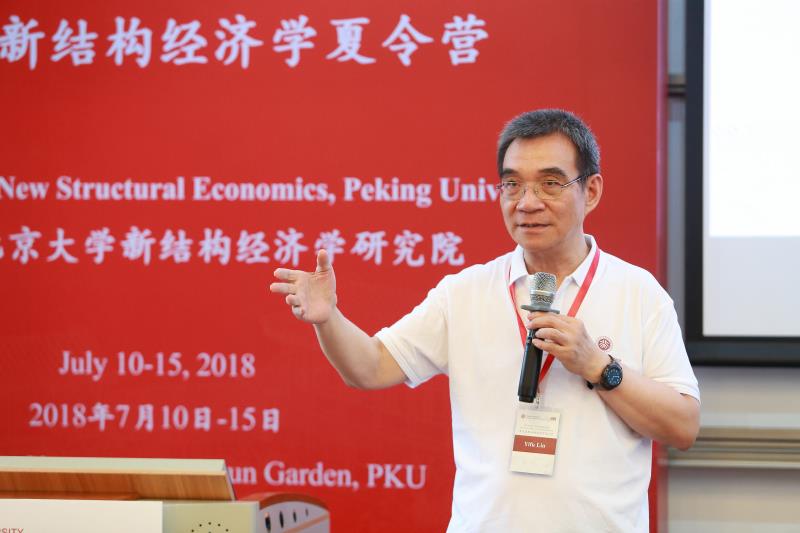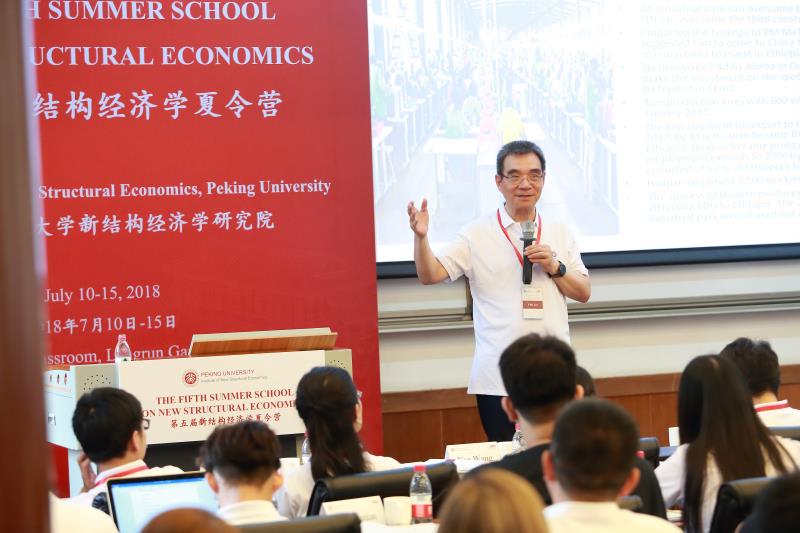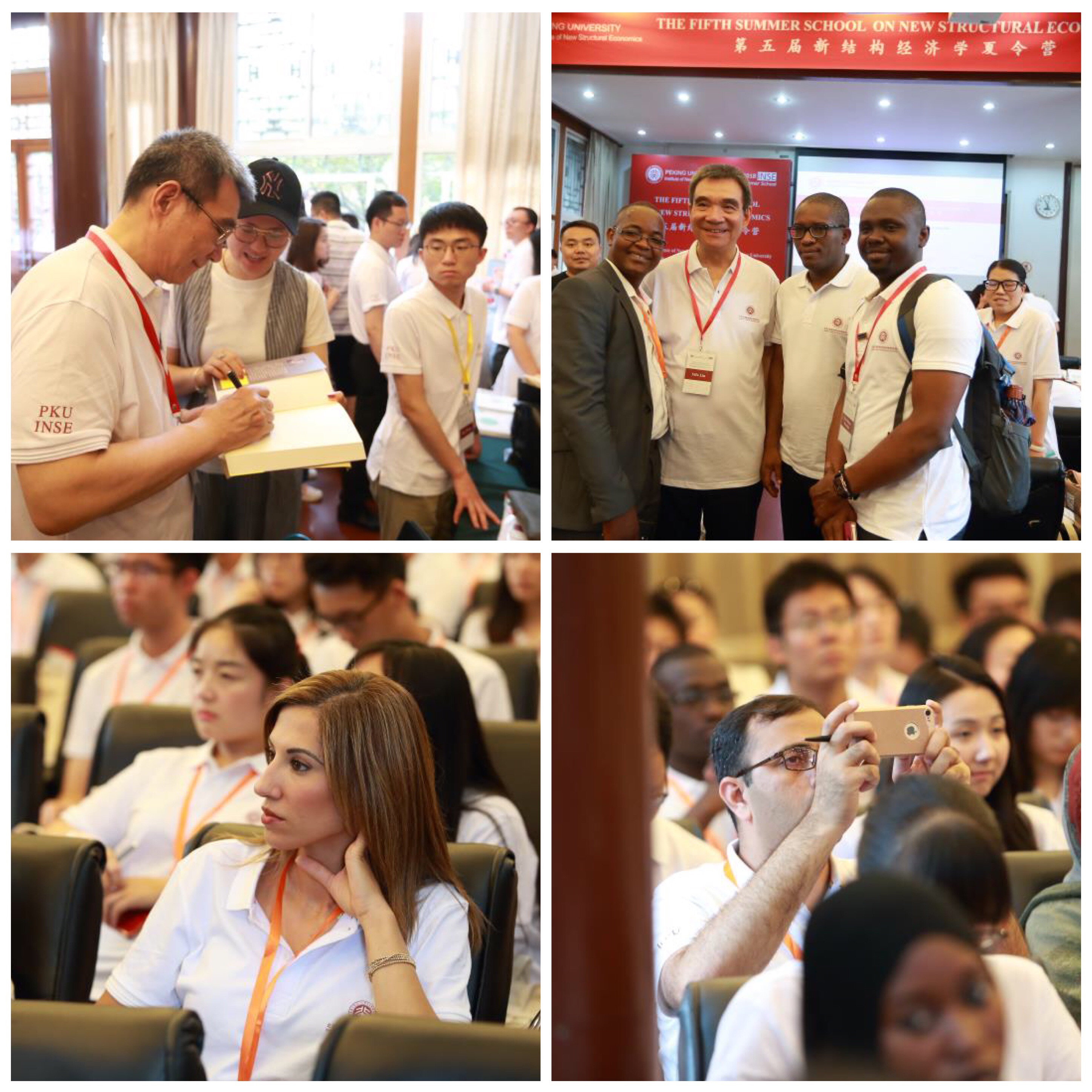Students﹀
【Fifth】Justin Yifu: New Structural Economics and its Policy Application
2018-07-20
Content introduction:

Professor Justin Yifu Lin explained why he proposed new structural economics for the rethinking of economic development theory. He advocated returning to Adam Smith's methododogy, an inquiry to the nature and causes of national wealth shown in the title of "The Wealth of Nations"; then detailed the theoretical basis of the New Structural Economics, including the theory of comparative advantage, the relationship between government and the market, and the explanation of the success or failure on economic development based on the New Structural Economics; then, he classified five types of industries in a middle-income country as examples to explain the application of New Structural Economics to the formation of industrial policy, and used theapplication of New Structural Economics in Ethiopia, Rwanda and Poland as illustrations. Finally, Professor Justin Yifu Lin proposed that the New Structural Economics as the third wave of development economics can bring hope and help to developing countries. The New Structural Economics suggests that developing countries should develop their industries according to the comparative advantages determined by their factor endowments. Each country has the potential to grow at a high speed and develop into a middle-income or even high-income country by this way.

1.Why do we need New Structural Economics
Economic theories need rethinking. After the WWII, many development theories aimed to help those developing countries to achieve the same living standard as the high-income countries. The first edition of development economics called Structuralism, as we all know, if we want to make a developing country as rich as a high-income country, then we need to have high productivity, but if you want to have the same high productivity as high-income country, then you should have the same advanced industries as high-income countries. However, those advanced industries will not appear spontaneously, so the Structuralism advocates the government in a developing country to adopt an Import Substitution Strategy to development them, but got disappointing results finally. Then we come to the second edition of the development economics, Neoliberalism, which focused on government failures and adopted Washington Consensus with a shock therapy to build up a well-functioning market, however, it failed again. We still don’t have an appropriate economic theory to help us to get the intended goal. But during this time, some countries achieved great success, like successful Asian tigers, which relied on the export promotion strategy, or like China, Vietnam and Mauritius, which adopted a gradual, dual-track approach to transition. They all have Market based economies with proactive state, under this circumstance, we need to rethink the development. This kind of result can’t be explained by the Structuralism nor the Neoliberalism, so I proposed New Structural Economics based on the observation of success and failures in developing countries. We need this kind of new theory to guide our actions.
Back to Adam Smith. But not to the ideas advocated by The Wealth of Nations, which reflect findings of Adam Smith’s research based on his observations of economic phenomena in the 18th century. Let’s go back to Adam Smith’s methodology, which is exemplified in the title of his book, An Inquiry into the Nature and Causes of the Wealth of Nations. Firstly, we need to understand the nature of modern economic growth. According to Madisson’s data, it is not difficult to find that the rapid, sustained income growth is a modern phenomenon, and the nature of modern income growth is a process of continuous structural transformation, including the structure of technologies and industries, which increases labor productivity and the structure of soft and hard infrastructure, which reduces transaction costs of the economy, happened only after the Industrial Revolution.
The New Structural Economics, is an application of neoclassical economic approach to study the determinants and impacts of economic structure and its evolution, which are the nature of modern economic growth, in an economy’s development. By convention, it should be called structural economics, but add “new” to distinguish it from the Structuralism.
2.The theoretical foundation of New Structural Economics
The main hypothesis of New Structural Economics is the endogenesity of economic structure, including the structure of technology, industry as well as both hard and soft infrastructure. The New Structural Economics proposes that economic structure, including the structure of technology, industry, hard and soft infrastructure, is endogenous to endowment structure, which is given at any specific time and changeable over time. The endowment structure determines the economy’s comparative advantages and thusthe optimal industrial structure, while the hard and soft infrastructure is endogenous to the need of industrial structure for reducing transaction costs and turning comparative advantages into competitive advantages. For a developing country, following an economy’s comparative advantage (determined by its endowment structure) to develop the economy’s industries and hard and soft infrastructure is the best way to achieve dynamic growth and convergence. The economy will be most competitive, produce the largest surplus, have the highest possible returns to capital and thus savings, ensure the fastest upgrading of endowments structure, and achieve the rapidest industrial upgrading and income growth. In this process, a developing country can have the latecomer advantages and thus have a faster technological innovation and industrial upgrading than high-income countries, which lead to convergence to high-income countries.
Viability is an important concept in the New Structural Economics. Viability means an enterprise with a normal management level in an open and freely competitive market environment can expect to obtain a socially acceptable normal profit level without relying on government or external subsidies. The viability of enterprises is the basis of micro-analysis of New Structural Economics. The viability depends on whether the technology used by the company and the industry in which it is located are consistent with the comparative advantage determined by the factor endowment structure. In this way, the factor cost of production is the lowest. When the soft and hard infrastructure in the economy is suitable, the transaction cost will be the lowest, thus having the strongest competitiveness, and the enterprise can survive without the government's protection or subsidy.
“Effective Market” and “Facilitating state”. The firms’ choice of technology and industries is based on the relative factor prices. Only if the relative factor prices reflect the relative scarcities of factors will firms’ choice of technology and industries be consistent with the comparative advantage determined by the factor endowments. And only in a competive market will the factor prices reflect the relative scarcity of factors. Therefore a competitive market is needed for an economy to develop its economy along its comparative advantage. A facilitating state is also needed because it is necessary to compensate the externality generated by the first movers in technological innovation and industrial upgrading. The success of first movers also dependson the state’s coordination or provision of.
Does the New Structural Economics offer explanation to the observed development success and failure? According to Michael Spence’s Growth Commission Report, after WWII, there were 13 economies achieving 7% or more for 25 years or more. These 13 economies have the following 5 common characteristics. Firstly, they are open, and they havethe macro stability, they also have high savings and high investments as well as a good market economy and competent, proactive government.. Spence suggests that these are ingredients of success but not the recipe for success. From NSE perspective, the recipe for development success is following an economy’s comparative advantage, then we need to have both market and a facilitating state as our institutional preconditions. If we develop our economy by following the comparative advantage, then we will get openness, and macro stability due to competitiveness and strong external as well as fiscal accounts, because there will be fewer home-grown crises and larger scope for countercyclical fiscal policies. The large economic surplus and high returns to investment will also be the results of this development method.
The explanation of the failure of Structuralism and Washington Consensus based on New Structural Economics. Firstly, let’s focus on the failure of Structuralism. As I have mentioned before, Structuralism advised governments to develop modern industries prevailing in high-income countries, that were too far advanced compared to their countries’ level of development and went against their comparative advantages. The firms were non-viable in open competitive market and required government subsidies and protection for their initial investment and continuous operations. The government subsidies and protection just led to misallocation of resources, rent-seeking, corruption, and political capture. As for the Washington Consensus, it failed to recognize that the distortions were endogenous to the need of protecting non-viable firms in the priority sectors and advised the government to eliminate all distortions immediately, which caused the collapse of old priority sectors. The Washington Consensus also opposed the government to adopt an industry-specific facilitation policy. Consequently, a comparative advantage industry is hard to become a country’s competitive advantage. Those reasons can explain why the Structuralism and Washington Consensus failed.
3.The New Structural Economics` application on industrial policy
According to New Structural Economics, a facilitating state is essential for rapid technological innovation, industrial upgrading, and economic diversification in a market economy because of the need to address externalities and solve coordination problems. The industrial policy is a useful instrument for a facilitating state, because the government’s resources and capacity are limited, so the government needs to use them strategically. However, the sad fact is that almost all governments in the world attempted to use industrial policies to play the facilitating role, but most failed. The reason is that the government’s targeted industries went against the country’s comparative advantages.
New Structural Economics` industrial policy. Depending on a targeted industry’s distance to the global technology frontier, there are five types of industrial policies in a middle-income country: first, industrial policy for catching up higher-income countries’ industries; second, industrial policy for maintaining the leading-edge industry’s technological leadership globally; third, industrial policy for helping firms exit from comparative-advantage losing industries; fourth, industrial policy for leapfrogging high-income countries in short innovation-cycle industries; Fifth, industrial policy for national defense-related industries.
(1) Growth Identification and Facilitation Framework (GIFF model) for catching up industries. It has six steps. Firstly, find fast-growing countries with similar endowment structures and with about 100% higher per capita income, or 20 years ago had a similar per capita income. Identify dynamically growing, tradable industries that have performed well in those countries over the last 20 years. Alternatively identify major imports that are produced in countries with about 100%-200% of per capita income. This step helps the government avoid doing the wrong things or being captured by vested groups for rent seeking. Secondly, see if some private domestic firms are already in those industries (existing or nascent). Identify constraints for the firms to be competitive in domestic and international market or further firm entry. Take actions to remove constraints. In the third step, we need to find the industries where no domestic firms are currently present, seek FDI from countries examined in step 1, or organize new firm incubation programs. As for the fourth step, in addition to the industries identified in step 1, the government should also pay attention to spontaneous self-discovery by private enterprises and give support to scale up successful private innovations in new industries. Then, in the countries with poor infrastructure and bad business environments, special economic zones or industrial parks may be used to overcome barriers to firm entry, attract FDI, and encourage industrial clusters, this is the fifth step. Finally, the government may compensate pioneer firms identified above with: tax incentives for a limited period, direct credits for investments and access to foreign exchange. We also need to pay attention to addressing the externality issue in the last step.
(2) Industrial policy for maintaining the leading-edge industry’s technological leadership globally in developed and developing countries. A developing country, especially for a middle-income country, may have some sectors which are on the global technology frontier, such as household electronic appliances in China, due to the exit of high-income countries from those sectors. To maintain technological leadership in those sectors, the firms need to have indigenous innovations in new technologies and products, which rely on R&D, and the government should support universities or research institutions for basic research related to the innovation of new technology in those sectors. Based on the breakthrough in basic research, the firms in those sectors should develop new technologies or products. The government can also use procurement to support the new products from the sectors, so the firms can reach economic scale of production quickly, government can also support the firms’ penetration into or expansion of the global market.
(3) Industrial policy for helping firms exit from comparative-advantage losing industries. Due to the rise of wage, a middle-income country may lose comparative advantages in some existing labor-intensive sectors. The government may adopt policies to support some firms to shift to higher value-added activities such as branding, product design, and market channel management, help other firms to relocate their production to lower wage regions or countries, and train existing workers for jobs in other sectors.
(4) Industrial policy for leapfrogging high-income countries in short innovation-cycle industries. New technologies in some modern industries, such as internet and mobile handsets, have short innovation cycle and require primarily human capital for innovation. The government in a middle-income country may encourage leapfrogging in such sectors by setting up incubation park, encouraging venture capitals, strengthening intellectual property protection and procurement of new products.
(5) industrial policy for national defense-related industries. A middle-income country may have to develop indigenously national defense industries, which are capital-intensive, require long innovation cycle and are against the country’s comparative advantages. Then the government needs to subsidize firms in such industries, no matter they are owned by the state or by the private. So, the subsidies are made either directly from fiscal appropriation or indirectly by prices or market distortions. It is better to provide subsidy directly as direct subsidy is more transparent, easier to supervise than indirect subsidies through distortions, and less costly to the economy.
The practice of new structural economics. New structural economics has been widely used abroad, such as the rapid success of Huajian footwear in Ethiopia, the rapid success of C&H garments in Rwanda and the successful application of new structural economics in Poland. In March 2011, according to the theory of the new structure, Professor Justin Yifu Lin suggested that Ethiopia should overcome the bottleneck restrictions of infrastructure and business environment through industrial parks, learn from China’s practice of top raking official to do investment promotion to attract investment in China. After a visit to Addis Ababa in October 2011, Huajian Shoes decided to invest in the Oriental Industrial Park and became a quick success in 2012 with 2000 employment at the end of the year and more than doubling Ethiopia’s leather export. The demonstration effect of Huajian Footwear has made an important contribution to Ethiopia's economic development and investment promotion work. Ethiopia is now the African country that attracts the most foreign direct investment, and foreign direct investment has increased fourfold between 2012 and 2017. In the case of widespread de-industrialization in Africa, industrial output has also increased fourfold. GDP grew at an average annual rate of 9.7%, making it the fastest growing country in Africa and the world. The successful experience of the structural transformation of Ethiopia has prompted Rwanda to adopt the same proposal from new structural economics. C&H garments have established in the special economic zone of the capital of Rwanda. The number of employees has increased from 200 in 2015 to 2,000 in 2017, making it the largest employer in Rwanda.. New structural economics has also been successfully applied in Poland. In 2016, the Polish President announced the development of a national development plan based on the theory of new structural economics. In 2017, Poland’s population accounted for one-tenth of the entire EU, creating jobs that accounted for 70% of the entire EU.
Two additional points, on the one hand, agricultural development is crucial for developing countries: for poverty reduction agricultural development also requires structural change in technology and product composition; on the other hand, a resource-abundant country’s resources will be a blessing if it has a good management of resources (e.g., some of it must be saved for future generations, and enclave rent capture avoided.), and it uses (part of) the wealth generated from resources to facilitate structural transformation.
4.New structural economics can bring hope and help to developing countries.
Ideas determine the result, developing countries cannot simply copy the theory and experience of developed countries. To change development performance in developing countries, we must first change our development thinking. The new structural economics suggests that developing countries should find their own factor endowment and obey the comparative advantage to build themselves bigger and stronger. As long as the government plays a facilitating role in the market and help the private sector to follow its own comparative advantage in the market economy system and exploit the late-comer advantage, each developing country has the potential to grow rapidly for decades, in one or two generations, it will develop into a middle-income country and even a high-income country.

References:
- Justin Yifu Lin, “New Structural Economics: The Third Wave of Development Thinking”, Asia Pacific Economic Literature, Vol. 27, Issue 2, November 2013, pp:1-13.
- Justin Yifu Lin, “Industrial policies for avoiding the middle-income trap: a new structural economics perspective,” Journal of Chinese Economic and Business studies, 2017 Vol. 15, no. 1, 5-18.
Written by: Chenxi Song
Proofread by: Prof. Yifu Lin
Li Hui

